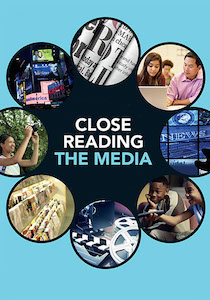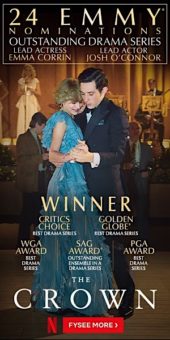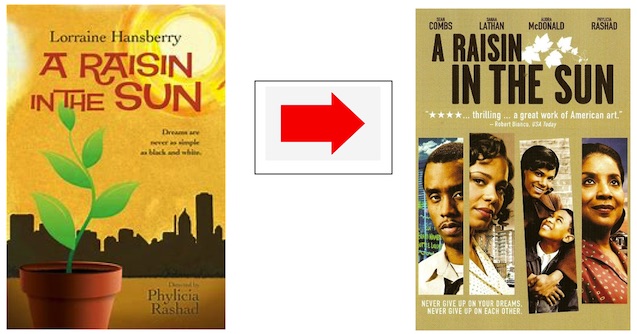It’s Emmy Award Time: Why Should We Care?

We know our students watch less traditional television than earlier generations, but in 2019 (before Covid quarantining) the typical 13-year old spent about 40 hours a week (outside of school) looking at screens – network, cable, YouTube, Netflix, and other video sources included. (Source)
Television is still a huge industry. The advent of streaming services has meant more programming than ever before. Not only do many millions of us watch weekly, there are hundreds of thousands who are employed in the medium and related industries.
The annual prime-time EMMY Awards (honoring television’s best) are scheduled for Sunday September 19 (broadcast on CBS-TV and Paramount+). The awards are presented by the Academy of TV Arts & Sciences, also known as the TV Academy.
Our students’ continuing interest in media recognized by the Emmys the subject of this blogpost.
More about the Emmys
The Emmy Awards recognize those both in front of the camera (actors) as well as those behind the camera (cinematography, scriptwriters, casting, art direction, lighting, costumes and much more). In 2020, awards were given in 28 areas of the industry, broken down into 123 categories.
Traditional TV networks (ABC, CBS, FOX, NBC) and cable (HBO, Showtime, National Geographic, etc.) now compete with streaming services (Amazon Prime, Hulu, Netflix, Disney+ et al) for EMMY Awards.
Nominations for major awards are announced in July each year and the winners are revealed in September in a globally televised ceremony. See who (and what) got nominated for the 2021 Emmy Awards in this Variety story. According to Variety:
HBO and HBO Max combined to take in a leading 130 total nominations, followed closely behind by Netflix with 129. Disney Plus had a significant jump from last year with 71 nominations in its second year of eligibility.
Netflix’s “The Crown” and Disney Plus’ “The Mandalorian” tied for a leading 24 nominations each, followed by Marvel and Disney Plus’ “WandaVision” with 23 and Hulu’s “The Handmaid’s Tale” with 21.
TV & Diversity in the News
Historically many television watchers have paid little attention to who is “left out.” In recent years, however, advocacy groups have increasingly called attention to the general lack of diversity in front of and behind the cameras and this has become a major issue in the film and TV industries.
The diversity concerns include both workers in the industry and the representation of groups of individuals in scripts and on-screen. Issues of race, gender and physical or mental status are all part of the diversity debate. Misrepresentation and stereotyping of certain groups is another related topic worthy of exploration by your students, who might begin with the latest annual study (10/2020) from the UCLA Hollywood Diversity Report.
What Does It Take To Win An Emmy?
Every year, TV-producing studios go to great lengths (and spend millions of dollars) to promote their shows, hoping to get the attention of Academy voting members.
That attention can take the form of “For Your Consideration” (FYC) advertisements in trade magazines; billboards in the areas around New York City and Los Angeles; and specially produced booklets highlighting what critics have said about a particular program. This year, Disney and HBO created “drive-in” theatre events to screen programs for voting members.
Here is an excellent site to view and analyze FYC advertising. Students might be interested in comparing heavily promoted programs with their eventual success (or lack thereof) in the Emmy Awards. Numerous FYC ads can also be found in the August 2020 issue of The Wrap magazine.

Students should choose a program to promote and research previously published critic testimonials. Ask them what else must be in their ad? Who are they trying to reach? Where might they publish their ad to reach the Emmy voting audience?
Language of the Moving Image
In many of my previous posts here at MiddleWeb, I’ve referenced the fact that media are texts, which can be read, analyzed and deconstructed. Television is no different.
I define the “language of the moving image” as both the tools and techniques which create and imply meaning. How a camera moves; how lighting creates mood; how costumes and setting convey information; how music builds emotion – these are all ways teachers can explore how television communicates. See my specially designed web page for education resources.
The Common Core ELA standards encourage students to learn how the technical aspects of a medium contribute to its meaning and effectiveness. The middle grade standards also encourage students to “Compare and contrast a text to an audio, video, or multimedia version of the text, analyzing each medium’s portrayal of the subject.” An example would be a novel with its made-for-TV adaptation.
The PBS “Masterpiece” series is an excellent starting place to locate English literature productions which can be used to satisfy this specific standard. I also found teacher guides to “Jane Austen” and “The Diary of Anne Frank.”
Identifying Structures within Genres
Since most English language arts teachers introduce genre in instruction, it seems natural to include TV to extend this learning. Asking students to name a science fiction program or series (for example) may result in answers such as “Stranger Things” (Netflix), “Star Trek” (Paramount/CBS), or a host of similar shows. See this brief discussion of TV genres for more insight.
In my workshops, I challenge teachers and students to go beyond simply identifying genre. They might also consider that specific genres use formulas.
For example, in the long running hour-long TV drama “Law and Order,” typically the crime occurs in the first few minutes, followed immediately by an investigation, a search for suspects and even some interrogations. By the second half-hour, the program moves into the trial phase. This is formula and you can almost set your watch to it. Even sit-coms (situation comedies) are formulaic. [See this revealing Atlantic article, Cracking The Sitcom Code.]
Activity: Using the list of current Emmy nominations, ask students to divide the nominations by genre and TV network. What conclusions can they draw? For example, what genre appears to be the favorite among this year’s Emmy voters? Which networks garnered the most nominations?
Conclusion
Students have favorite TV shows and genres. Experienced educators already know that they must take the time, and make the effort, to explore the popular culture texts of their students in order to engage them in learning.
Using television as an example is another great way to show we appreciate TV and acknowledge its ability to attract and build an audience.
I hope you will consider how you can encourage your students to conduct a close reading of television and how it can benefit their learning.
For even more background about the Emmys
see these earlier columns by Frank Baker:
Use the Emmy Awards to Teach Media Literacy
Use the Emmy Awards as a Versatile Teaching Tool
Recommended Resources
► Just What Are The Awards Shows Awarding? (by Kareem Abdul-Jabbar)
► Diversity and Entertainment (Black Lives In The Media)
► 2 in 3 Black Americans Don’t See Themselves Represented in TV and Film
► Geena Davis Institute on Gender in Media
► How To Win An Emmy: Secrets Revealed
► Teaching Television to Empower Students (Subscription required)
► Critical Media Literacy: TV Programs (lesson plans)
► Media Literacy: Examining the World of TV Teens (lesson plan)
► Can Television Be Considered Literature and Taught in English Classes?
► Commercial and Advertising Techniques (lesson plan)

































Great, timely ideas! Thanks!
Read which shows took home Creative Arts Emmy Awards
https://gizmodo.com/the-mandalorian-rocks-the-creative-emmy-awards-1847665831